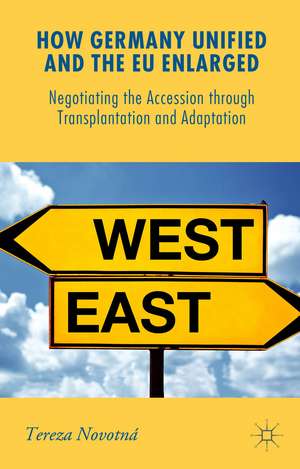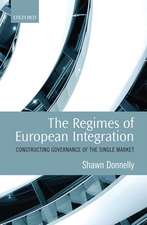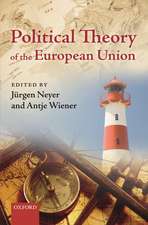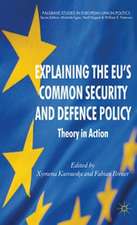How Germany Unified and the EU Enlarged: Negotiating the Accession through Transplantation and Adaptation: New Perspectives in German Political Studies
Autor Tereza Novotnáen Limba Engleză Hardback – 5 oct 2015
Din seria New Perspectives in German Political Studies
-
 Preț: 384.31 lei
Preț: 384.31 lei -
 Preț: 391.61 lei
Preț: 391.61 lei -
 Preț: 410.07 lei
Preț: 410.07 lei -
 Preț: 389.70 lei
Preț: 389.70 lei - 15%
 Preț: 643.00 lei
Preț: 643.00 lei -
 Preț: 387.75 lei
Preț: 387.75 lei - 15%
 Preț: 637.93 lei
Preț: 637.93 lei - 15%
 Preț: 642.68 lei
Preț: 642.68 lei -
 Preț: 386.39 lei
Preț: 386.39 lei - 15%
 Preț: 644.49 lei
Preț: 644.49 lei - 15%
 Preț: 648.24 lei
Preț: 648.24 lei -
 Preț: 388.72 lei
Preț: 388.72 lei -
 Preț: 390.63 lei
Preț: 390.63 lei -
 Preț: 390.25 lei
Preț: 390.25 lei -
 Preț: 389.70 lei
Preț: 389.70 lei -
 Preț: 390.63 lei
Preț: 390.63 lei - 15%
 Preț: 643.65 lei
Preț: 643.65 lei - 15%
 Preț: 643.84 lei
Preț: 643.84 lei -
 Preț: 384.86 lei
Preț: 384.86 lei -
 Preț: 390.63 lei
Preț: 390.63 lei - 15%
 Preț: 641.03 lei
Preț: 641.03 lei -
 Preț: 387.38 lei
Preț: 387.38 lei -
 Preț: 389.49 lei
Preț: 389.49 lei -
 Preț: 393.52 lei
Preț: 393.52 lei - 15%
 Preț: 640.55 lei
Preț: 640.55 lei -
 Preț: 385.84 lei
Preț: 385.84 lei - 15%
 Preț: 638.11 lei
Preț: 638.11 lei - 15%
 Preț: 639.73 lei
Preț: 639.73 lei - 15%
 Preț: 638.43 lei
Preț: 638.43 lei -
 Preț: 384.70 lei
Preț: 384.70 lei -
 Preț: 389.31 lei
Preț: 389.31 lei - 15%
 Preț: 641.71 lei
Preț: 641.71 lei
Preț: 389.11 lei
Nou
Puncte Express: 584
Preț estimativ în valută:
74.45€ • 77.95$ • 61.61£
74.45€ • 77.95$ • 61.61£
Carte tipărită la comandă
Livrare economică 05-19 aprilie
Preluare comenzi: 021 569.72.76
Specificații
ISBN-13: 9781137477606
ISBN-10: 1137477601
Pagini: 235
Ilustrații: XVIII, 235 p.
Dimensiuni: 140 x 216 x 16 mm
Greutate: 0.44 kg
Ediția:1st ed. 2015
Editura: Palgrave Macmillan UK
Colecția Palgrave Macmillan
Seria New Perspectives in German Political Studies
Locul publicării:London, United Kingdom
ISBN-10: 1137477601
Pagini: 235
Ilustrații: XVIII, 235 p.
Dimensiuni: 140 x 216 x 16 mm
Greutate: 0.44 kg
Ediția:1st ed. 2015
Editura: Palgrave Macmillan UK
Colecția Palgrave Macmillan
Seria New Perspectives in German Political Studies
Locul publicării:London, United Kingdom
Cuprins
TABLE OF CONTENTS LIST OF TABLES LIST OF FIGURES ACKNOWLEDGEMENTS LIST OF ABBREVIATIONS 1 CHAPTER 1: POLITICAL INTEGRATION IN EUROPE AFTER 1989: AN INTRODUCTION 1.1 MAIN AIMS AND THEMES OF THE BOOK 1.2 NATURE OF THE RESEARCH AND METHODOLOGY OF THE BOOK 1.3 STRUCTURE OF THE BOOK 2 CHAPTER 2: TRANSPLANTATION AND ADAPTATION MODELS OF POLITICAL INTEGRATION: A THEORETICAL FRAMEWORK 2.1 THEORETICAL FRAMEWORK I: GENERAL CHARACTERISTICS OF TWO MODELS OF POLITICAL INTEGRATION 11 2.1.1 Speed and Timing of the Transplantation Model of Political Integration 2.1.2 Strong Leadership and Procedural Character of the Transplantation Model of Political Integration 2.1.3 Speed and Conditionality of the Adaptation Model of Political Integration 2.1.4 Bureaucratic Leadership and Consensual Character of the Adaptation Model of Political Integration 2.2 THEORETICAL FRAMEWORK II: PROCESSES OF TWO MODELS OF POLITICAL INTEGRATION 2.2.1 Institutional, Economic, and Elite Transfers as the Basis for Implementing the Transplantation Model of Political Integration 2.2.2 Institutional, Economic, and Elite Building as the Basis for Implementing the Adaptation Model of Political Integration 2.3 SPEED AND IMPACT OF THE DOMESTIC ACTORS: TWO MAIN DISTINGUISHING FEATURES OF THE TWO MODELS OF POLITICAL INTEGRATION 2.4 CONCLUSION 3 CHAPTER 3: THE UNIFICATION OF GERMANY: A CASE OF THE TRANSPLANTATION MODEL OF POLITICAL INTEGRATION 3.1 THE TRANSPLANTATION MODEL OF POLITICAL INTEGRATION CLARIFIED: SPEED AND IMPACT OF THE DOMESTIC ACTORS DURING THE UNIFICATION OF GERMANY 3.2 TEARING DOWN THE BERLIN WALL: DEMOCRATIZATION VS. INTEGRATION 3.2.1 Local Actors I: Masses 3.2.2 Local Actors II: The Reform Communists 3.2.3 The Wall and Kohl: the External Actors 3.2.4 Local Actors III: The Opposition 3.2.5 'Vor der Einheit kam die Freiheit' (Gauck) 3.3 THE 10 POINT PROGRAM ENTER KOHL : A STRONG LEADER IN CHARGE 3.4 THE MARCH 1990 VOLKSKAMMER ELECTIONS: TRANSPLANTING THE PARTY SYSTEM 3.4.1 The Unification of the CDU andthe Allianz für Deutschland 3.4.2 Campaign 3.4.3 Results 3.4.4 Formation of the New East German Government 3.5 ECONOMIC AND MONETARY UNION AND THE STATE TREATY PUTTING THE FOOT ON THE GAS: TRANSPLANTING THE ECONOMICS 3.5.1 Key drivers of the process 3.5.2 Key Decisions 3.5.3 The Consequences of the Economic Transplantation 3.6 GERMAN UNIFICATION ACT I: CONCLUSION 4 CHAPTER 4: NEGOTIATING THE EAST GERMAN ACCESSION: ACT II OF GERMAN UNIFICATION 4.1 ELECTIONS AND UNIFICATION: DISPUTES OVER DATES AND LAWS 4.2 NEGOTIATIONS 4.3 MISSED AND TAKEN OPPORTUNITIES: THE IMPACT OF THE EAST ON THE NEGOTIATIONS 4.4 MORE INTERNATIONAL NEGOTIATIONS, EVEN LESS IMPACT 4.5 GERMAN UNIFICATION ACT II: CONCLUSION 5 CHAPTER 5: EASTERN ENLARGEMENT OF THE EU: A CASE OF THE ADAPTATION MODEL OF POLITICAL INTEGRATION 5.1 THE ADAPTATION MODEL OF POLITICAL INTEGRATION CLARIFIED: A SLOWER AND VARIABLE SPEED AND HIGHER IMPACT OF THE DOMESTIC ACTORS DURING THE EASTERN ENLARGEMENT OF THE EU 5.2 THE WINDS OF CHANGE AND RETURN TO EUROPE: AN OVERTURE TO THE ENLARGEMENT 5.3 COPENHAGEN CRITERIA: A FOUR-POINT PROGRAM OF POLITICAL CONDITIONALITY 5.4 FROM COPENHAGEN TO NICE VIA LUXEMBOURG AND HELSINKI: ADAPTING TO THE PROSPECT OF ENLARGEMENT 5.5 THE COMMISSION AND PRE-ACCESSION PROGRAMS: FINANCING AND ASSESSING THE INSTITUTION BUILDING 5.6 EU EASTERN ENLARGEMENT ACT I: CONCLUSION 6 CHAPTER 6: NEGOTIATING THE CZECH ACCESSION TO THE EU: ACT II OF EU EASTERN ENLARGEMENT 6.1 THE NEGOTIATIONS, THEIR STRUCTURES, AND THE IMPACT OF THE ENTERING COUNTRIES 6.1.1 Power Asymmetry of the EU Accession Negotiations 6.1.2 Negotiations at the Accepting EU Side 6.1.3 Structure of Negotiations 6.1.4 Role of the Rotating Presidency and the Commission During Negotiations 6.1.5 The Applicants' Chief Negotiators 6.1.6 Negotiating Tactics 6.2 COORDINATING THE CZECH POSITION AT HOME AND ABROAD 6.2.1 Coordination at Home 6.2.2 Coordination Abroad 6.3 POLITICAL VS. TECHNICAL ISSUES 6.3.1 Negotiating the Technical Issues: Chapters andTransition Periods 6.3.2 Negotiating the Political Issues: Temelín and Bene Decrees 6.4 THE COPENHAGEN SUMMIT AND ITS AFTERMATH 6.4.1 Negotiating at the Copenhagen Summit 6.4.2 Negotiating the EU Accession at Home 6.5 EU EASTERN ENLARGEMENT ACT II: CONCLUSION 7 CHAPTER 7: EVALUATING THE UNIFICATION OF GERMANY AND THE EASTERN ENLARGEMENT OF THE EU 7.1 WE THE PEOPLE: THE PUBLIC'S EVALUATION OF POLITICAL INTEGRATION 7.2 THE VIEW FROM THE TOP: THE ELITES' EVALUATION OF POLITICAL INTEGRATION 7.3 CONCLUSION 8 CHAPTER 8: LESSONS LEARNED FROM THE TRANSPLANTATION AND ADAPTATION MODELS OF POLITICAL INTEGRATION: A CONCLUSION LIST OF INTERVIEWS: THE UNIFICATION OF GERMANY EASTERN ENLARGEMENT OF THE EU BIBLIOGRAPHY
Recenzii
“In this book, Tereza Novotná explores the negotiation processes that led to German unification and Czech membership in the European Union. Through the material gained from around 80 interviews with key actors the book makes an original contribution to existing academic literature on transformation and integration and to recollections of actors involved. … Those who want to read the story of integration re-told through the lenses of the two models and their categories might very well benefit from the book.” (Barbara Lippert, Journal of Common Market Studies, Vol. 55 (1), 2017)
“Tereza Novotná’s latest book takes the reader on a fascinating journey into the political dynamics of one of the most dramatic periods in recent European history … . this makes for fascinating reading and is an elegant reflection on the complexities involved in both transitions. … book isa great read for anyone looking to explore the dynamics of state integration in a period of rapid change, and offers fresh insights into a hugely significant aspect of contemporary European history.” (Carolyn Rowe, German Politics, Vol. 25 (3), August, 2016)
“Tereza Novotna examines the inter-relationship between these two epoch-making events, pointing to the different methods of accession – transplantation and adaptation. … Novotna’s research findings will be useful as the EU contemplates further enlargement to the Western Balkans and Turkey. … this book will be essential reading for practitioners on all sides.” (Fraser Cameron, The International Spectator, Vol. 51 (3), 2016)
“Tereza Novotná’s latest book takes the reader on a fascinating journey into the political dynamics of one of the most dramatic periods in recent European history … . this makes for fascinating reading and is an elegant reflection on the complexities involved in both transitions. … book isa great read for anyone looking to explore the dynamics of state integration in a period of rapid change, and offers fresh insights into a hugely significant aspect of contemporary European history.” (Carolyn Rowe, German Politics, Vol. 25 (3), August, 2016)
“Tereza Novotna examines the inter-relationship between these two epoch-making events, pointing to the different methods of accession – transplantation and adaptation. … Novotna’s research findings will be useful as the EU contemplates further enlargement to the Western Balkans and Turkey. … this book will be essential reading for practitioners on all sides.” (Fraser Cameron, The International Spectator, Vol. 51 (3), 2016)
Notă biografică
Tereza Novotná is an FNRS Post-Doctoral Researcher at Université Libre de Bruxelles, Belgium. She received her doctorate from Boston University and has held various visiting fellowships in the US, UK, Germany and Austria. She has widely published on various aspects of EU politics, especially EU foreign policy, transatlantic relations and the politics of Germany and Central and Eastern Europe.
Textul de pe ultima copertă
Based on original empirical research that includes 90 interviews with key leaders, this book compares and contrasts negotiations during the processes of German unification and Eastern enlargement of the EU, with particular attention to the Czech Republic. It develops two models of political integration and suggests that such integration can take place by means of a take-over (Transplantation), or by the joining entity adjusting to the norms and institutions of the accepting party (Adaptation). In addition to an exploration of these two different models and a detailed examination of the two cases, the book points to other historical examples of Transplantation and Adaptation and formulates lessons for where future research might travel, temporarily and geographically, in the cases of other political integrations. Providing new insights into German unification and European integration, this text is key reading for academics, advanced undergraduate and graduate students in EU Politics,as well as policy-makers and the wider public.
















